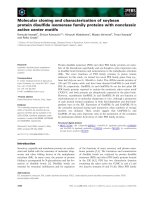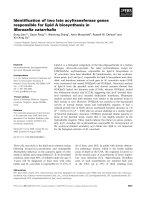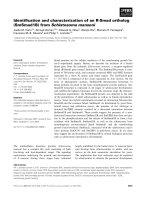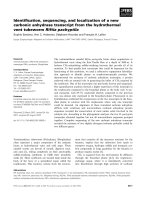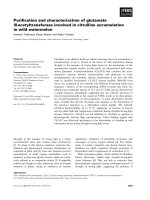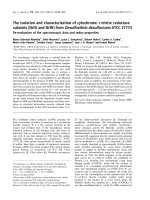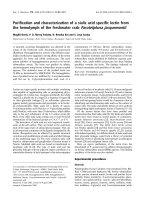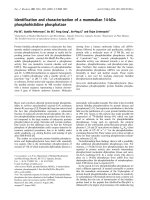Tài liệu Báo cáo Y học: Identification and characterization of a mammalian 14-kDa phosphohistidine phosphatase pdf
Bạn đang xem bản rút gọn của tài liệu. Xem và tải ngay bản đầy đủ của tài liệu tại đây (257.78 KB, 8 trang )
Identification and characterization of a mammalian 14-kDa
phosphohistidine phosphatase
Pia Ek
1
, Gunilla Pettersson
1
,BoEk
2
, Feng Gong
1
, Jin-Ping Li
1
and O
¨
rjan Zetterqvist
1
1
Department of Medical Biochemistry and Microbiology, Uppsala University, Uppsala, Sweden;
2
Department of Plant Biology,
The Swedish University of Agricultural Sciences, Uppsala, Sweden
Protein histidine phosphorylation in eukaryotes has been
sparsely studied compared to protein serine/threonine and
tyrosine phosphorylation. In an attempt to rectify this by
probing porcine liver cytosol with the phosphohistidine-
containing peptide succinyl-Ala-His(P)-Pro-Phe-p-nitro-
anilide (phosphopeptide I), we observed a phosphatase
activity that was insensitive towards okadaic acid and
EDTA. This suggested the existence of a phosphohistidine
phosphatase different from protein phosphatase 1, 2A
and 2C. A 1000-fold purification to apparent homogeneity
gave a 14-kDa phosphatase with a specific activity of 3
lmolÆmin
)1
Æmg
)1
at pH 7.5 with 7 l
M
phosphopeptide I
as substrate. Partial amino-acid sequence determination of
the purified porcine enzyme by MS revealed similarity
with a human sequence representing a human chromo-
some 9 gene of hitherto unknown function. Molecular
cloning from a human embryonic kidney cell cDNA-
library followed by expression and purification, yielded a
protein with a molecular mass of 13 700 Da, and an
EDTA-insensitive phosphohistidine phosphatase activity
of 9 lmolÆmin
)1
Æmg
)1
towards phosphopeptide I. No
detectable activity was obtained towards a set of phos-
phoserine-, phosphothreonine-, and phosphotyrosine pep-
tides. Northern blot analysis indicated that the human
phosphohistidine phosphatase mRNA was present pre-
ferentially in heart and skeletal muscle. These results
provide a new tool for studying eukaryotic histidine
phosphorylation/dephosphorylation.
Keywords: dephosphorylation; N-phosphorylation; phos-
phoamidase; phosphopeptide; protein histidine phospha-
tase.
Boyer and coworkers detected protein-bound phosphohis-
tidine in rat-liver mitochondrial succinyl-CoA synthetase
almost 40 years ago [1,2]. Despite the long time interval and
the fact that phosphohistidine represents a substantial
fraction of eukaryotic protein-bound phosphate [3], only a
few phosphohistidine-containing proteins have been detec-
ted compared to the large number of eukaryotic proteins
phosphorylated on serine, threonine and tyrosine residues.
One reason for this difference may be that the N-bound
phosphate of phosphohistidine easily escapes detection by
common analytical procedures, due to its lability under
acidic conditions, e.g. during fixation and staining of gels
after SDS/PAGE [4].
The studies on eukaryotic protein histidine phosphory-
lation and dephosphorylation have dealt with essentially
two aspects. One is the intermediary phosphorylation of
enzymes [5–10], of which nucleoside diphosphate kinase is a
particularly well-studied example. The other is the reversible
protein histidine phosphorylation by protein kinases and
phosphatases [3,11]. An important contribution to the latter
field was the purification of a yeast protein histidine kinase
in 1991 [12]. Access to this enzyme also made possible the
preparation of
32
P-labelled histone H4, which was later
used as substrate in the search for phosphohistidine
phosphatases. Using such an approach, the catalytic
subunits of the well-studied serine/threonine protein phos-
phatases 1, 2A and 2C were shown to display k
cat
/K
m
values
in the order of 10
6
)10
7
M
)1
Æs
)1
for the phosphohistidine-
containing histone H4. These values were at least as high as
those for their naturally occurring phosphoserine-contain-
ing substrates [13,14].
Notwithstanding these findings, there is still a possibility
that additional phosphohistidine phosphatases exist. For
instance, a 13-kDa bovine liver phosphoamidase has been
reported to possess activity also towards intermediary
phosphorylated nucleoside diphosphate kinase and succi-
nyl-CoA synthetase [15]. In a recent review [16], data in
press on a 14-kDa phosphatase from rabbit liver that
dephosphorylates the phosphohistidine of autophosphory-
lated ATP-citrate lyase is reported [17].
In the search for new phosphohistidine phosphatases we
tried a different approach. It seemed reasonable to assume
that the immediate environment of the N-phosphate of
protein-bound phosphohistidine can influence its sensitivity
to a phosphatase. Of potential interest in such a context was
the finding that the rate of isomerization of the histidine-
proline bond in the peptide Suc-Ala-His-Pro-Phe-pNA is
influenced by the degree of protonation of its imidazole ring
Correspondence to J P. Li, Department of Medical Biochemistry
and Microbiology, Box582, SE-751 23 Uppsala, Sweden.
Fax: + 46 18 4714209, Tel. + 46 18 4714241,
E-mail:
Abbreviations: His(P), phosphohistidine; MDEA, N-methyl-dietha-
nolamine; phosphopeptide I, Suc-Ala-His(P)-Pro-Phe-pNA;
pNA, p-nitroanilide.
Note: The nucleotide sequence for human 14-kDa phosphohistidine
phosphatase has been submitted to the GenBank Nucleotide Sequence
Database under the accession number AF393504.
(Received 9 June 2002, revised 21 August 2002,
accepted 27 August 2002)
Eur. J. Biochem. 269, 5016–5023 (2002) Ó FEBS 2002 doi:10.1046/j.1432-1033.2002.03206.x
[18]. We therefore performed a chemical N-phosphorylation
of the imidazole of this peptide by means of phospho-
amidate, and used Suc-Ala-His(P)-Pro-Phe-pNA (phospho-
peptide I) as a probe to search for new phosphohistidine
phosphatases. As the result of that screening we detected a
14-kDa phosphatase in porcine liver cytosol and were also
able to ascribe phophohistidine phosphatase activity to a
14-kDa protein coded for by a human chromosome 9 gene.
EXPERIMENTAL PROCEDURES
Materials
Phosphoamidate was prepared according to the method of
Wei and Matthews [4]. Suc-Ala-His-Pro-Phe-pNA was
purchased from Bachem AG, Switzerland. Malachite green
reagent was obtained from Apoteksbolaget, So
¨
dersjukhuset,
Stockholm, Sweden. MDEA was bought from Riedel de
Hae
¨
n. Diisopropyl fluorophosphate was from Fluka
Chemie AG, Switzerland. Phenylmethanesulfonyl fluoride
and okadaic acid were from Sigma. Trypsin of modified
sequencing grade was obtained from Promega, and LysC of
Achromobacter lytii from Wako. The O-phosphorylated
phosphopeptides EQTRsLDGR-NH
2
, DHTGFLtEY-
VATRWC-NH
2
, DADEyL-NH
2
, EGDNDyIIPL-NH
2
,
KKPRyEIRW-NH
2
, and LIEDNEyTARQGA-NH
2
(phosphorylated residues indicated by lower-case) were gifts
from Mrs Ulla Engstro
¨
m at the Ludwig Institute of Cancer
Research, Uppsala. The O-phosphopeptides GRRPsLFG
and APDyTTPEMY-NH
2
were obtained from Dr A
˚
ke
Engstro
¨
m at the Peptide Synthesis and Analysis Laboratory
of the Department of Medical Biochemistry and Microbio-
logy, Uppsala University. The SP6 primer 5¢-ATT TAG
GTG ACA CTA TAG-3¢ and the three oligonucleotide
PCR-primers described below were from DNA Technology
A/S, Denmark. The T7 primer 5¢-TAA TAC GAC TCA
CTA TAG GG-3¢ and protein molecular weight references
were from Amersham Biosciences. Terminator ready reac-
tion mix was from PE Biosystems. DEAE cellulose (DE-52)
was from Whatman, Sephadex G-200 Fine, Mono Q HR 5/5
columns, and the gel filtration columns Sephadex G-25
PD-10, Superose 12 HR 10/30, Superose 12 PC 3.2/30, and
Superdex 75 PC 3.2/30 were from Amersham Biosciences.
Preparation of the phosphohistidine-containing peptide
Suc-Ala-His(P)-Pro-Phe-pNA
The protocol used was adapted from that used for the
synthesis and isolation of free 3-phosphohistidine by Wei
and Matthews [4]. Phosphoamidate (275 m
M
)andthe
peptide Suc-Ala-His-Pro-Phe-pNA (25 m
M
) were incubated
at room temperature for 48 h in a total volume of 200 lL.
The mixture was then diluted with 2
M
MDEA, pH 9.0, and
100% methanol to give 1.6 m
M
peptide in 0.13
M
MDEA/
20% methanol, and applied to a 1-mL Mono Q column
equilibrated with 0.13
M
MDEA, pH 9.0, containing 20%
methanol. After washing with 2 mL of equilibration buffer,
the phosphopeptide was eluted with a 25-mL linear gradient
of 0.13–1.17
M
MDEA in 20% methanol at 1 mLÆmin
)1
.
The pNA-containing phosphopeptide I, which was traced
by its absorbance at 315 nm, appeared as a peak at 0.33
M
MDEA and was essentially stable in this buffer at +4 °C
for at least 4 months. The phosphate content of the
phosphopeptide was analysed by the malachite green
method [19]. The peptide concentration was calculated by
using the molar absorbancy 13 600 of pNA at 315 nm. The
nature of the phosphohistidine isomer in phosphopeptide I
was not determined, but it was considered to be 3-phos-
phohistidine, rather than 1-phosphohistidine, due to the
48 h phosphorylation time used [4,20].
Phosphatase assays
The standard assay of the phosphohistidine phosphatase
activity was performed at 30 °C and pH 7.5 in a 150-lL
reaction mixture consisting of 25 m
M
Hepes, 15 m
M
MDEA, 1 m
M
MgCl
2
and 7 l
M
phosphopeptide I. The
reaction was stopped after 10–30 min by addition of 2
M
KOH to give pH 12.5. After 10 min incubation at 0 °C, 1
M
HCl was added to give pH 9.0. The mixture was then
applied to a 1-mL Mono Q column equilibrated in 0.085
M
MDEA, pH 9.0, in 20% methanol. After washing with
2 mL of the equilibration buffer, elution was performed
with a 25-mL linear gradient of MDEA from 0.085
M
to
0.765
M
in 20% methanol at 1 mLÆmin
)1
. The absorbance
at 315 nm was monitored and the degree of dephosphory-
lation was calculated from the peak areas of phosphorylated
and dephosphorylated peptides. In a control experiment,
the stoichiometry of the cleavage was confirmed by the
occurrence of equal amounts of orthophosphate and
unphosphorylated Suc-Ala-His-Pro-Phe-pNA. The identity
of the peptide product was controlled by amino acid
analysis.
In initial phosphohistidine phosphatase assays with
porcine liver cytosol, the phosphorylated and dephosphory-
lated peptides were separated on a 24-mL Superose 12
column in 0.10
M
MDEA, pH 9.0. In this system,
phosphopeptide I was eluted after 0.5 column volumes,
whereas the corresponding dephosphopeptide was eluted
after 0.9 column volumes. Both peptides were traced by the
absorbance at 315 nm.
Phosphoamidase activity of the porcine liver phospho-
histidine phosphatase was assayed by incubating the
phosphatase with 1 m
M
phosphoamidate in 25 m
M
Hepes,
pH 7.5, at 30 °C for 30 min [15]. The released orthophos-
phate was measured by a modification of the method of
Martin and Doty [21], using toluene instead of benzene. To
keep background hydrolysis of the acid-labile phospho-
amidate as low as possible, the sample (200 lL), isobutanol/
toluene 1 : 1 (250 lL), and 5% ammonium molybdate in
2
M
H
2
SO
4
(50 lL) were added in that order, and extraction
was performed by immediate vortex-mixing in a capped
Eppendorf test-tube for 15 s, followed by centrifugation in
an Eppendorf centrifuge at 8000 g for 1 min. The phos-
phomolybdate was determined by the absorbance at
720 nm obtained after mixing 130 lL of the organic phase
with 130 lLofacidethanoland6.25lL of dilute SnCl
2
,
prepared as described [21].
The activity of human recombinant phosphohistidine
phosphatase, prepared as described below, was tested
against the eight O-phosphopeptides containing phospho-
serine, phosphothreonine or phosphotyrosine, described
under Materials. The phosphopeptides were incubated at
50 l
M
final concentration under the conditions of the
standard phosphohistidine phosphatase assay. The reaction
was interrupted by mixing 100 lL aliquots of the reaction
Ó FEBS 2002 A mammalian 14-kDa phosphohistidine phosphatase (Eur. J. Biochem. 269) 5017
mixtures with 100 lLof1
M
HClina96-wellmicrotitration
plate, followed by 50 lL of malachite green reagent [19].
After 60 min, A
620
wasmeasuredinaTitertekÒ Multiskan
from Flow Laboratories.
Preparation of porcine liver cytosol
For small-scale preparation of cytosol, 10 g of fresh
porcine liver obtained from the local abattoir was
homogenized for 1 min at 600 r.p.m. in three volumes
of homogenization buffer (0.25
M
sucrose, 10 m
M
Hepes,
pH 7.5, 1 m
M
EDTA and 1 m
M
diisopropyl fluorophos-
phate) using a 50-mL Potter-Elvehjem homogenizer with a
loose-fitting Teflone rotor (diameter of 24.6 mm). This
was followed by one stroke of a standard, tight-fitting
rotor (25.2 mm). For large-scale preparations, batches of
100 g porcine liver each were homogenized in a 1-L
Turmix mixer for 10 s at full speed. In both cases, the
homogenates were centrifuged at 600 g for 10 min in a
refrigerated centrifuge, followed by centrifugation of the
supernatant at 14 500 g for 5 min. The latter supernatant
was then centrifuged at 45 500 g for 2 h.
Purification of phosphohistidine phosphatase
from porcine liver cytosol
A mixture of 320 mL 10 m
M
Hepes, pH 7.5 and 320 mL of
cytosol from 130 g of liver, was stirred for one hour with
600 mL of DEAE-cellulose, equilibrated in 25 m
M
Hepes,
pH 7.5. The slurry was then packed into a column
(6.5 · 18 cm), washed with 3600 mL of equilibration buf-
fer, and eluted with a 2000 mL linear gradient of 0–0.5
M
NaCl in equilibration buffer. The phosphohistidine phos-
phatase, which appeared at 0.15
M
NaCl, was concentrated
fivefold with a Diaflo membrane YM-10, Amicon. The
material was divided into two 10-mL aliquots, each of which
was chromatographed on a Sephadex G-200 column
(3 · 30.5 cm) in 50 m
M
Hepes, pH 7.5. Fractions with
phosphohistidine phosphatase activity were pooled, diluted
with one volume of water and filtered through a 0.2-lm
Millipore filter. A total of 20 mL, representing 50% of the
material from one G-200 column, was loaded onto a 1-mL
Mono Q column equilibrated in 25 m
M
Hepes, pH 7.5.
Elution was performed with a 20-mL linear gradient of
0–0.5
M
NaCl in equilibration buffer at a flow-rate of
1mLÆmin
)1
. The enzyme, which appeared at 80 m
M
NaCl,
was further purified on a 2.4-mL Superose-12 column
equilibrated and eluted with 25 m
M
Hepes, pH 7.5, con-
taining 150 m
M
NaCl. All purification steps were performed
at 4 °C. Protein was estimated from the absorbance at
280 nm [22]. The purified protein was analysed by SDS/
PAGE [23].
Amino acid sequencing by MS
Samples containing purified porcine liver phosphohistidine
phosphatase were digested with trypsin or LysC as
described [24]. The peptide mixtures were analysed by MS
and sequence determinations of selected peptides were
performed by MS/MS in a Q-tof mass spectrometer,
equipped with a nanospray interface (Micromass,
Manchester, UK). All MS data were processed and
analysed with
MASSLYNX
software programs.
RNA isolation and molecular cloning of human
phosphohistidine phosphatase cDNA
Human embryonic kidney cells (HEK293) were grown in
Dulbecco’s modified Eagle’s medium supplemented with
10% fetal bovine serum, 60 lgÆmL
)1
of penicillin and
50 lgÆmL
)1
of streptomycin until confluence. The cells were
trypsinized and washed with NaCl/P
i
(15 m
M
phosphate
buffer, pH 7.4, in 135 m
M
NaCl). Total RNA was extracted
according to the LiCl/urea/SDS procedure of Sambrook
et al. [25]. About 1 lg of the RNA was used as template for
RT-PCR. Single strand cDNA was prepared in a volume of
20 lL with First Strand cDNA Synthesis Kit for RT-PCR
(Roche). The PCR apparatus was a PTC 100 from MJ
Research Inc.
A portion (2 lL)ofthesinglestrandcDNAwasusedfor
amplification of the potential phophohistidine phosphatase
cDNA. The PCR primers were based on a human
nucleotide sequence reported from GenBank (accession
number AF164795) which contained a putative 378 bp
coding domain for a protein containing sequences homo-
logous to peptides of the purified porcine protein. The sense
primer (5¢-ATG GCG GTG GCG GAC CTC GCT CTC
AT-3¢) corresponded to bp 9–34 of AF164795 and the
antisense primer (5¢-TCA GTA GCC GTC GTT AGC
CCA GGT GA-3¢) corresponded to bp 361–386 at the
3¢-end, including the stop codon. PCR was performed under
the conditions: 1 cycle of 95 °C for 3 min, 35 cycles each of
95 °C for 30 s, 68 °C for 30 s and 72 °C for 1 min, and a
final extension at 72 °C for 10 min. The PCR product was
3¢-adenylated, inserted into the TOPO-TA Cloning Vector
pCRÒ II TOPO, and transformed to a competent bacter-
ium (TOP10, Invitrogen), as described in the protocol
provided by the manufacturer. One of the clones that
contained the complete coding sequence was chosen for
further processing.
Nucleotide sequencing
Nucleotide sequencing was performed on clones of the
pCRÒII TOPO (Invitrogen) and pET-24a(+) (Novagen)
vectors carrying the inserts. T7 and Sp6 primers were used
for both sense and antisense strands. The BigDye termina-
tor method from Perkin-Elmer was used according to the
instructions of the manufacturer. Sequencing was carried
out in ABI Prism 310 Genetic Analyser from Perkin-Elmer.
Expression of the human phosphohistidine phosphatase
recombinant protein
In order to permit the expression of a protein without tags,
an expression construct was generated using the chosen
clone as the template. The sense primer used was 5¢-CAT
ATGGCGGTGGCGGACCTCGCT-3¢, corresponding
to nucleotides 1–21 of the coding sequence, preceded by a
NdeI cleavage site at the 5¢-end. The antisense primer was
the same as used for cloning. When the sequence had been
confirmed, the insert was cut out by NdeIandNotI, and
subsequently ligated into the expression vector pET-
24a(+). The expression construct was introduced into
BL21(DE3) bacterial cells and selected on LB-agar plates
containing kanamycin (50 lgÆmL
)1
). Single colonies were
picked and cultured at 37 °C with and without 1 m
M
5018 P. Ek et al. (Eur. J. Biochem. 269) Ó FEBS 2002
isopropyl thio-b-
D
-galactoside in 5 mL LB medium con-
taining kanamycin (50 lgÆmL
)1
). Cells were collected and
lysedin0.5mLof25m
M
Hepes (pH 7.5) containing 2 m
M
phenylmethanesulfonyl fluoride, 10 lgÆmL
)1
pepstatin A,
100 lgÆmL
)1
lysozyme and 5 m
M
EDTA. After freezing,
thawing, and ultrasonic treatment the supernatant was
collected and analysed for phosphohistidine phosphatase
activity.
The clone with the highest activity was cultured in
500 mL LB medium at 37 °C in the presence of kanamycin
(50 lgÆmL
)1
) to an absorbance of 0.64 at 600 nm. Expres-
sion of the recombinant protein was then induced by
addition of isopropyl thio-b-
D
-galactoside (1 m
M
). After
6 h, the cells were collected by centrifugation at +4 °Cand
4000 g for 10 min, washed twice in NaCl/P
i
and frozen at
)70 °C. The frozen pellet was later thawed, suspended in
10 mL 25 m
M
Hepes buffer, pH 7.5, containing 2 m
M
phenylmethanesulfonyl fluoride, 10 lgÆmL
)1
pepstatin A
and 5 m
M
EDTA and passed four times through a French
Press. The cell lysate was centrifuged at 17 000 g for 10 min
and the resulting supernatant was used for purification of
the recombinant protein.
Purification of the recombinant phosphohistidine
phosphatase
A 9-mL sample of the supernatant of the bacterial lysate
was chromatographed on a Sephadex G-200 column
(3 · 30.5cm), in 50m
M
Hepes, pH 7.5. The fractions
containing the phosphatase activity were pooled to give
38 mL, of which 34 mL was diluted with 34 mL of water
and loaded onto a 1-mL DEAE-cellulose column equi-
librated with 25 m
M
Hepes, pH 7.5. Elution was per-
formed with a 10-mL gradient of 0–0.5
M
NaCl in the
same buffer, at 0.5 mLÆmin
)1
. Phosphohistidine phospha-
tase activity was assayed with phosphopeptide I as the
substrate. Protein was estimated from the absorbance at
280 nm [22] and by the Bradford method using bovine
serum albumin as standard [26]. Chromatographic frac-
tions were analysed by SDS/PAGE [23]. The size of the
active, purified recombinant phosphohistidine phosphatase
was estimated by chromatography on Superdex 75 in
25 m
M
Hepes, pH 7.5, containing 150 m
M
NaCl. Amino
acid sequencing of tryptic fragments was performed by
MS as described above. The intact recombinant protein
was also analysed by MS.
Northern blot analysis
The cDNA of the full coding sequence of the human
phosphohistidine phosphatase was labelled with [
32
P]dCTP
in a reaction with Klenow enzyme (Roche), and used as a
probe in hybridization to a Human Multiple Tissue
Northern (MTNÒ) blot (Clontech). The amount of mRNA
was claimed by the manufacturer to be the same in each lane
of this blot. The hybridization was carried out in Expres-
sHyb Hybridization Solution (Clontech) at 60 °C for one
hour and the blot was then washed with 0.1 · NaCl/Cit
containing 0.5% SDS at 60 °C(1· NaCl/Cit was 150 m
M
NaCl in 15 m
M
sodium citrate, pH 7.0). The membrane was
exposed to an X-ray film for 2 days.
RESULTS
Probing for a potential phosphohistidine phosphatase
in porcine liver cytosol
After passage through a column of Sephadex G-25 (PD-10),
porcine liver cytosol showed a phosphohistidine phospha-
tase activity of 0.003 lmolÆmin
)1
Æmg
)1
protein when tested
against 7 l
M
phosphopeptide I. No inhibition of the
dephosphorylation was observed in the presence of 1 l
M
okadaic acid, nor did 1 m
M
EDTA in the absence of 1 m
M
magnesium chloride inhibit the enzyme.
Purification of phosphohistidine phosphatase
from porcine liver
A phosphohistidine phosphatase with the specific activity
3 lmolÆmin
)1
Æmg
)1
at pH 7.5, measured with 7 l
M
phos-
phopeptide I was obtained after a 1000-fold purification
from the porcine liver cytosol (Table 1). At pH 5.6, the
activity was only 9% of that at pH 7.5. No activity was
detected at pH 9.0. The specific activity toward 1 m
M
phosphoamidate was 0.6 lmolÆmin
)1
Æmg
)1
. After the Mono
Q step, the enzyme could be stored at )20 °Cfor1year
with less than 50% loss of activity. The last purification step
on Superose 12 gave an apparently pure protein with a K
av
of 0.5, almost equal to the reference protein pancreatic
ribonuclease, with the known molecular mass of 13.7 kDa.
On SDS/PAGE, the purified material migrated as a single
band with an apparent molecular mass of 14 kDa (not
shown). These results indicated that the purified, active
enzyme was monomeric.
Amino acid sequencing
In order to clone the enzyme, amino acid sequencing by MS
was performed on peptides obtained by digestion of the
purified porcine enzyme with trypsin or LysC. The resulting
peptide sequences are shown in Table 2. Using these
peptides as probes during searching through sequence
databases, we found a cDNA from human adrenal glands
(accession number AF164795) [27].
Table 1. Purification of porcine liver phosphohistidine phosphatase. The purification was performed as described under Experimental procedures.
Step Total activity (lmolÆmin
)1
) Yield (%) Specific activity (lmolÆmin
)1
Æmg
)1
) Purification factor
Cytosol 13.6 100 0.0028 1.0
DEAE 4.04 29.7 0.0043 1.5
Sephadex G-200 1.98 14.6 0.053 18.0
Mono-Q 0.50 3.7 0.56 200
Superose 12 0.14 1.0 2.72 971
Ó FEBS 2002 A mammalian 14-kDa phosphohistidine phosphatase (Eur. J. Biochem. 269) 5019
Cloning and expression of a human 14-kDa
phosphohistidine phosphatase
Based on the human sequence data a pair of primers was
designed for PCR cloning using a cDNA-library derived
from human embryonic kidney cells as template. The
378-bp cDNA-fragment obtained was confirmed by sequen-
cing to be identical to the human cDNA reported
(AF164795). This DNA-fragment was inserted into an
expression vector and the expression in bacteria was induced
by isopropyl thio-b-
D
-galactoside. The phosphohistidine
phosphatase activity in the bacterial lysate was about
40-fold higher than that observed with bacteria not treated
with isopropyl thio-b-
D
-galactoside. After purification to
apparent homogeneity, the recombinant protein displayed a
phosphohistidine phosphatase activity towards phospho-
peptide I. The specific activity was 9 lmolÆmin
)1
Æmg
)1
at
pH 7.5. At pH 5.6, the activity was only 2% of that
at pH 7.5. No activity was detected at pH 9.0. The
pH-dependence of the recombinant human enzyme was
thus similar to that of the porcine liver enzyme.
The specificity of the recombinant enzyme towards
phosphohistidine was supported by the finding that none
of the eight O-phosphorylated peptides described under
Experimental procedures were detectably dephosphory-
lated; i.e. the cleavage was < 0.01 nmolÆmin
)1
in experi-
ments with an amount of phosphatase sufficient to cleave
N-phosphorylated phosphopeptide I in the standard assay
attherateof0.30nmolÆmin
)1
.
The purified human recombinant phosphohistidine phos-
phatase showed only one band in SDS/PAGE, with an
apparent molecular mass of about 14 kDa. Upon chroma-
tography on a Superdex 75 PC 3.2/30 column, the active
human enzyme migrated as 13.7-kDa bovine pancreatic
ribonuclease (data not shown). Thus, the recombinant
protein was active as a monomer, as was the case also with
the purified porcine enzyme. The nucleotide sequence of the
cloned human cDNA and the corresponding amino acid
sequence are shown in Fig. 1. The identity of the expressed
protein was confirmed by amino acid sequencing of tryptic
peptides (Fig. 1, underlined sequence segments). The ana-
lysis showed that the N-terminal peptide lacked the
N-terminal formyl-Met expected from the nucleotide
sequence. This finding was confirmed by MS-analysis of
the intact, purified recombinant protein, which displayed a
molecular mass of 13 700 Da (Fig. 2), compatible with the
average molecular mass (13 701 Da) calculated for the
polypeptide containing amino acids 2–125 of the predicted
sequence. The MS-data, collected under standard condi-
tions for obtaining the protein mass, did not indicate the
existence of any cofactors tightly bound to the enzyme.
The recombinant phosphohistidine phosphatase had
apparently been subjected to N-terminal processing in the
bacteria, since both the expected N-formyl group of
N-terminal formyl-Met and the Met itself were absent.
This usually occurs when alanine is the second amino acid
[28]. Whether this alanine is the natural N-terminus of the
phosphatase in human tissues remains to be determined.
Messenger RNA expression
When the full coding sequence for the human phospho-
histidine phosphatase was used as the probe in a human
multiple tissue Northern blot, we found that a 0.6-kb
Fig. 1. Nucleotide sequence of cloned cDNA from human embryonic
kidney cells, and the corresponding amino-acid sequence of the recom-
binant protein. The sequence data have been submitted to GenBank
under the accession number AF393504. The underlined sequences
indicate tryptic fragments derived from the purified recombinant
protein and sequenced by MS, as described under Experimental
procedures.
Table 2. Peptides from purified porcine liver phosphohistidine phospha-
tase sequenced by MS. The amino acid sequences of peptides from the
porcine enzyme are compared with the amino acid sequence (accession
number AAF80759) corresponding to a cDNA from human adrenal
glands (accession number AF164795). Amino acid sequencing by MS
was performed as described under Experimental procedures.
Peptide
number Sequence
Homologous
sequence
in AAF80759
1 LAAADLAQIPDVDIDSDGVFK 1–21
2 KWAEYHADIYDK 48–59
3 GLDCECLGGGR 68–78
4 SVTWADDGY 117–125
Fig. 2. MS of recombinant human phosphohistidine phosphatase. MS
was performed as described under Experimental procedures. Decon-
voluted and declustered (M + H
+
) mass peaks were collected
between 13 400 and 14 100.
5020 P. Ek et al. (Eur. J. Biochem. 269) Ó FEBS 2002
mRNA, i.e. the size of AF164795, was expressed predomi-
nantly in the heart and skeletal muscle tissue, whereas the
expression in liver was comparatively low (Fig. 3). Heart,
skeletal muscle and pancreas in particular also contained
larger sized mRNA that hybridized with the probe.
Sequence comparisons
Homologues were found in a few species when the amino
acid sequence of human phosphohistidine phosphatase was
used as the query for searching translated sequences of
nonredundant nucleotide and EST databases at the NCBI
site. No putative conserved domains were displayed. The
alignment is shown in Fig. 4. When the nucleotide sequence
of the putative mRNA of the human phosphatase
(AF164795) was used as the query, the phosphatase gene
was found to be located on chromosome 9 (9q34.3).
Comparison with the continuous nucleotide sequence of this
part of the chromosome (accession number AL355987)
showed that the phosphatase gene contains three exons
(Fig. 5). A sequence of 82 bp of the noncoding-3¢-terminus
overlaps with the noncoding 5¢-terminus of another gene of
unknown function in human. The mRNA (accession
number XM_088463) corresponding to the latter gene
showed homology to the mRNA of a rat apical endosomal
glycoprotein (accession number L37380).
DISCUSSION
The present work describes the detection, isolation and
partial amino acid sequencing of a porcine liver 14-kDa
phosphohistidine phosphatase, and the consequential iden-
tification, cloning and expression of a corresponding,
human 14-kDa phosphohistidine phosphatase. The fortu-
nate choice of the phosphohistidine-containing peptide
Suc-Ala-His(P)-Pro-Phe-pNA (phosphopeptide I) as the
probing substrate was essential for this outcome.
Phosphatases 1, 2A and 2C represent most of the protein
phosphohistidine phosphatase activity in liver cytosol when
assayed with 5 l
M
phosphohistidine-containing histone H4
[29]. This activity was about twofold higher than that
observed in the present work using phosphopeptide I. Still,
the dephosphorylation of the phosphopeptide by porcine
liver cytosol was apparently not due to protein phos-
phatases 1, 2A and 2C as judged from the lack of inhibition
by okadaic acid and EDTA. Phosphopeptide I therefore
seems to be a suitable substrate for estimates of the 14-kDa
phosphohistidine phosphatase activity in crude extracts that
also contain other phosphatases.
The identification of natural substrates of the 14-kDa
phosphohistidine phosphatase will be a major task in the
Fig. 3. Expression of histidine phosphatase mRNA in human tissues. A
human multiple-tissue Northern blot was hybridized with human
phosphohistidine phosphatase cDNA (upper panel) and b-actin
cDNA (lower panel). The full-length cDNA probes were labelled with
[
32
P]dCTP in a reaction with Klenow enzyme. The hybridization was
carried out in ExpressHyb Hybridization Solution (Clonetech) at
60 °C for 1 h and the blot was then washed with 0.1 · NaCl/Cit
containing 0.5% SDS at 60 (°C). The membrane was exposed to an X-
ray film for 2 days. The mRNA-size (kb) is indicated at the right
margin.
Fig. 4. Alignment of human phosphohistidine
phosphatase to homologous proteins. The
amino acid sequence of human phosphohis-
tidine phosphatase (Fig. 1) was used as the
query in a search against translated se-
quences of nonredundant nucleotide and
EST databases at the NCBI site (http://
www.ncbi.nlm.nih.gov/blast). For alignment
to the human query sequence, homologous
mouse, bovine and porcine sequences were
selected.
Ó FEBS 2002 A mammalian 14-kDa phosphohistidine phosphatase (Eur. J. Biochem. 269) 5021
future investigation of the physiological role of the enzyme.
A few conditions may be worth considering in this context.
Firstly, one group of phosphohistidine-containing pro-
teins to be considered as possible natural substrates of the
phosphohistidine phosphatase is that of enzymes that are
intermediary phosphorylated on a histidine of the active
site. Hiraishi et al. reported on the dephosphorylation of
nucleoside diphosphate kinase in their study of the 13-kDa
bovine liver phosphoamidase [15], which also has some
properties similar to the 14-kDa phosphatase. However, the
rate of this dephosphorylation, as calculated from their
data, appears to be slower by several orders of magnitude
than the rates reported for the dephosphorylation elicited by
physiological concentrations of native substrates, such as
ADP, cf [30,31]. The direct contribution by the phospho-
amidase activity to the in vivo turnover of the phospho-
histidine of nucleoside diphosphate kinase may therefore be
negligible. A similar reservation may be worth consideration
also for other combinations of phosphatases and interme-
diary phosphorylated enzymes. Therefore, kinetic data on
the dephosphorylation of autophosphorylated ATP-citrate
lyase in the paper in press by Klumpp et al. [17] will be
highly interesting in this context.
Secondly, no further clues to the physiological role of the
phosphatase were obtained when a translated
BLAST
search
was performed against nonredundant nucleotide and EST
databases at the NCBI site, though homologues were found
in a few species. Alignment of the human, mouse, bovine
and porcine sequences (Fig. 4) showed that the protein is
considerably conserved, indicating an important functional
role of the phosphatase. It is noteworthy that none of these
proteins have so far been assigned an enzymatic activity,
except a human amino acid sequence (CAC16267) retriev-
able from the patent division of GenBank. This sequence
wasreferredtoasÔprotein histidine phosphataseÕ from its
homology with the rabbit-liver protein histidine phos-
phatase, studied by Klumpp et al. [17].
Thirdly, the gene of the phosphohistidine phosphatase
was found to overlap with a gene showing homology to the
mRNA of a rat apical endosomal glycoprotein which is
targeted to early endosomes [32,33]. Whether the small
amounts of larger sized mRNA seen in the Northern blot in
addition to the 0.6 kb mRNA mirrors alternative splicing
remains to be studied. A putative simultaneous expression
of the 14-kDa phosphohistidine phosphatase and an
endosomal protein may be of interest in the light of the
recently described histidine phosphorylation of annexin I
from a membrane preparation of ovine tracheal epithelia
[34]. Although the detailed subcellular location of the
phosphorylated annexin I was not reported, and the effect
of the 14-kDa phosphatase on phosphorylated annexin I is
still unknown, it is worth noting that annexin I shows
endosomal binding in live HeLa cells [35].
In conclusion, the native substrates of the 14-kDa
phosphohistidine phosphatase described in the present
work remain to be identified, but the mere existence of this
unique phosphatase should offer new possibilities to the
area of eukaryotic histidine phosphorylation and dephos-
phorylation.
ACKNOWLEDGEMENTS
We thank Dr Helena Larsson for stimulating discussions during the
initial phase of this project and Dr A
˚
sa Haglund for valuable help with
the layout of the manuscript. The work has been funded by the Swedish
Medical Research Council (Project 13X-04485), Swedish Agricultural
and Forestry Research Council (Project 729.1181/97), and by Poly-
sackaridforskning AB, Uppsala.
REFERENCES
1. Boyer,P.D.,DeLuca,M.,Ebner,K.E.,Hultquist,D.E.&Peter,
J.B. (1962) Identification of phosphohistidine in digests from a
probable intermediate of oxidative phosphorylation. J. Biol.
Chem. 237, 3306–3308.
2. Mitchell, R.A., Butler, L.G. & Boyer, P.D. (1964) The association
of readily-soluble bound phosphohistidine from mitochondria
with succinate thiokinase. Biochem. Biophys. Res. Commun. 16,
545–550.
3. Matthews, H.R. (1995) Protein kinases and phosphatases that act
on histidine, lysine, or arginine residues in eukaryotic proteins: a
possible regulator of the mitogen-activated protein kinase cascade.
Pharmacol. Ther. 67, 323–350.
4. Wei, Y.F. & Matthews, H.R. (1991) Identification of phospho-
histidine in proteins and purification of protein-histidine kinases.
Methods Enzymol. 200, 388–414.
5. Fothergill-Gilmore, L.A. & Watson, H.C. (1989) The phos-
phoglycerate mutases. Adv. Enzymol. Relat. Areas Mol. Biol. 62,
227–313.
6. Elshourbagy, N.A., Near, J.C., Kmetz, P.J., Wells, T.N.C., Groot,
P.H.E., Saxty, B.A., Hughes, S.A., Franklin, M. & Gloger, I.S.
(1992) Cloning and expression of a human ATP-citrate lyase
cDNA. Eur. J. Biochem. 204, 491–499.
7. Schwander, W.R.E., Jime
´
nez, B., Schwartz, A., Weijer, C.J.,
Behrens, M., Mazo
´
n, M.J. & Ferna
´
ndez-Renart, M. (1993)
Chemotactic stimulation of aggregation-stage Dictyostelium cells
induces rapid changes in energy metabolism, as measured by
succinic thiokinase phosphorylation. Biochim. Biophys. Acta 1176,
175–182.
8. More
´
ra, S., Chiadmi, M., LeBras, G., Lascu, I. & Janin, J. (1995)
Mechanism of phosphate transfer by nucleoside diphosphate
kinase: X-ray structures of the phosphohistidine intermediate of
Fig. 5. Putative genomic organization of the human phosphohistidine phosphatase gene. Astandard
BLAST
search, with AF164795 as the query, was
performed against the nonredundant databases at the NCBI site. In that way, the gene of the human phosphohistidine phosphatase was found to be
located on chromosome 9 (9q34.3) and to contain three exons. The coding sequences are shown as black boxes, and the noncoding sequences as
grey boxes. Horizontal lines represent introns. Overlap between the noncoding-3¢-end of the human phosphohistidine phosphatase gene and the
noncoding 5¢-end of a gene, corresponding to a mRNA (accession number XM_088463) with similarity to a rat apical endosomal protein mRNA
(accession number L37380), is represented by a checked box.
5022 P. Ek et al. (Eur. J. Biochem. 269) Ó FEBS 2002
the enzymes from Drosophila and Dictyostelium. Biochemistry 34,
11062–11070.
9.Gottlin,E.B.,Rudolph,A.E.,Zhao,Y.,Matthews,H.R.&
Dixon, J.E. (1998) Catalytic mechanism of the phospholipase D
superfamily proceeds via a covalent phosphohistidine inter-
mediate. Proc. Natl Acad. Sci. USA 95, 9202–9207.
10. Okar, D.A., Live, D.H., Devany, M.H. & Lange, A.J. (2000)
Mechanism of the bisphosphatase reaction of 6-phosphofructo-
2-kinase/fructose-2,6-bisphosphatase probed by
1
H-15NNMR
spectroscopy. Biochemistry 39, 9754–9762.
11. Matthews, H.R. & Chan, K. (2001) Protein histidine kinase.
Methods Mol. Biol. 124, 171–182.
12. Huang, J., Wei, Y., Kim, Y., Osterberg, L. & Matthews, H.R.
(1991) Purification of a protein histidine kinase from the yeast
Saccharomyces cerevisiae. The first member of this class of protein
kinases. J. Biol. Chem. 266, 9023–9031.
13. Kim,Y.,Huang,J.,Cohen,P.&Matthews,H.R.(1993)Protein
phosphatases 1, 2A, and 2C are protein histidine phosphatases.
J. Biol. Chem. 268, 18513–18518.
14. Kim, Y., Pesis, K.H. & Matthews, H.R. (1995) Removal of
phosphate from phosphohistidine in proteins. Biochim. Biophys.
Acta 1268, 221–228.
15. Hiraishi, H., Yokoi, F. & Kumon, A. (1999) Bovine liver phos-
phoamidase as a protein histidine/lysine phosphatase. J. Biochem.
126, 368–374.
16. Klumpp, S. & Krieglstein, J. (2002) Phosphorylation and depho-
sphorylation of histidine residues in proteins. Eur. J. Biochem. 269,
1067–1071.
17.Klumpp,S.,Hermesmeier,J.,Selke,D.,Bechmann,G.,
Krieglstein, J., Van den Brulle, J., Weidner, G., Sharm, B.,
Gu
¨
ssow, D., Baumester, R. & Kellner, R. (2002) Vertebrate
protein histidine phosphatase: identification and functional
studies. EMBO Reports, in press.
18. Reimer, U., El Mokdad, N., Schutkowski, M. & Fischer, G.
(1997) Biochemistry 36, 13802–13808.
19. Haglund, A
˚
., Ronquist, G., Frithz, G. & Ek, P. (2000) Alteration
of the fibrinogen molecule and its phosphorylation state in myo-
cardial infarction patients undergoing thrombolytic treatment.
Thromb. Res. 98, 147–156.
20. Medzihradszky, K.F., Phillipps, N.J., Senderowicz, L., Wang, P.
& Turck, C.W. (1997) Synthesis and characterization of histidine-
phosphorylated peptides. Protein Sci. 6, 1405–1411.
21. Martin, J.B. & Doty, D.M. (1949) Determination of inorganic
phosphate. Modification of isobutyl alcohol procedure. Anal.
Chem. 21, 965–967.
22. Stoscheck, C.M. (1990) Quantitation of protein. Methods Enzy-
mol. 182, 50–68.
23. Laemmli, U.K. (1970) Cleavage of structural proteins during
the assembly of the head of bacteriophage T4. Nature 227, 680–
685.
24. Wilm, M., Shevchenko, A., Houthaeve, T., Breit, S., Schweigerer,
L., Fotsis, T. & Mann, M. (1996) Femtomole sequencing of
proteins from polyacrylamide gels by nano-electrospray mass
spectrometry. Nature 379, 466–469.
25. Sambrook, J., Fritsch, E.F. & Manniatis, T. (1989) Molecular
Cloning: a Laboratory Manual, 2nd edn. Cold Spring Harbor
Laboratory, Cold Spring Harbor, NY.
26. Bradford, M.M. (1976) A rapid and sensitive method for the
quantitation of microgram quantities of protein utilizing the
principle of protein-dye binding. Anal. Biochem. 72, 248–254.
27. Hu, R.M., Han, Z.G., Song, H.D., Peng, Y.D., Huang, Q.H.,
Ren,S.X.,Gu,Y.J.,Huang,C.H.,Li,Y.B.,Jiang,C.L.,Fu,G.,
Zhang, Q.H., Gu, B.W., Dai, M., Mao, Y.F., Gao, G.F., Rong,
R.YeM., Zhou, J., Xu, S.H., Gu, J., Shi, J.X., Jin, W.R., Zhang,
C.K.,Wu,T.M.,Huang,G.Y.,Chen,Z.,Chen,M.D.&Chen,
J.L. (2000) Gene expression profiling in the human hypothalamus-
pituitary-adrenal axis and full-length cDNA cloning. Proc. Natl
Acad.Sci.USA97, 9543–9548.
28. Meinnel, T., Mechulam, Y. & Blanquet, S. (1993) Methionine as
translation start signal: a review of the pathway in Escherichia coli.
Biochimie 75, 1061–1075.
29. Matthews, H.R. & MacKintosh, C. (1995) Protein histidine
phosphatase activity in rat liver and spinach leaves. FEBS Lett.
364, 51–54.
30. Wa
˚
linder, O., Zetterqvist, O
¨
.&Engstro
¨
m, L. (1969) Intermediary
phosphorylation of bovine liver nucleoside diphosphate kinase.
Studies with a rapid mixing technique. J. Biol. Chem. 244, 1060–
1064.
31. Schaertl, S., Konrad, M. & Greeves, M.A. (1998) Substrate spe-
cificity of human nucleoside-diphosphate kinase revealed by
transient kinetic analysis. J. Biol. Chem. 273, 5662–5669.
32. Speelman, B.A., Allen, K., Grounds, T.L., Neutra, M.R.,
Kirschhausen, T. & Wilson, J.M. (1995) Molecular characteriza-
tion of an apical early endosomal glycoprotein from developing
rat intestinal epithelial cells. J. Biol. Chem. 270, 1583–1588.
33. Wilson, J.M. & Colton, T. (1997) Targeting of an intestinal apical
endosomal protein to endosomes in nonpolarized cells. J. Cell
Biol. 136, 319–330.
34. Muimo, R., Hornickova, Z., Riemen, C.E., Gerke, V.,
Matthews, H. & Metha, A. (2000) Histidine phosphorylation of
annexin I in airway epithelia. J. Biol. Chem. 275, 36632–36636.
35. Rescher, U., Zobiak, N. & Gerke, V. (2000) Intact Ca
2+
-binding
sites are required for targeting of annexin 1 to endosomal mem-
branes in living HeLa cells. J. Cell Sci. 113, 3931–3938.
Ó FEBS 2002 A mammalian 14-kDa phosphohistidine phosphatase (Eur. J. Biochem. 269) 5023


